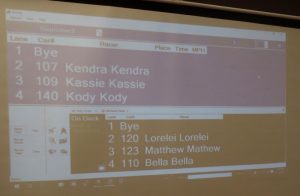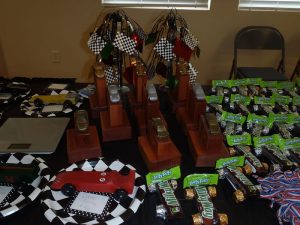Skip to content
Competitive Derby Race
Competitive Pinewood Derby Race day
a typical schedule of events
- Competitive Derby Race Set-up: We roll in two boxes and some other gear.

- Computer: We set-up a laptop computer and small projector on a table or on the stacked boxes. We run some wires to get the starting gate, end gate, projector, and computer talking and powered. Then start up the race management program. The program uses the first name, last name, and car number. Car number can’t be zero as the program is just not able to handle that. (Providing the information ahead of time by email allows for optimal results and prevents delays.) The program then makes a schedule that tries to ensure as fair a race as possible. After setting up the track, we run a few test races using our fleet of test cars to ensure accuracy and functioning as expected.
- Race Track: The track; made by Best Track, is 35 to 45 feet long and comes in 6-7 parts that have to be carefully joined and clamped to ensure a smooth fast track. This takes some time to do properly. After the track is assembled barrier pylons are erected and checkered flag-ropes are strung between to prevent individuals from jumping over and standing on the track.
- Other: The projector screen is in three parts that can be quickly assembled. The screen is approximately 8ft . on an edge so very large auditoriums may be better suited by an on site projector system. The system is adequate for basket-ball court sized rooms. We have found that the best placement is with the starting gate, car table, and projector against one wall with the track going down the middle of the room to allow viewing on both sides. The boxes mentioned above stack and can be used to store cars between races and as a general work area for us.
- Racing Main Heat(s)

- The main heat or heats use all racers running once per lane. The projector will display current racers and the next “on-deck” group. Between races the projector will display rankings, times, and scale speeds; our default scale is 1 inch=25 inches. Cars will need to be placed on the starting gate and retrieved from the finish line multiple times. We find allowing the scouts to do so keeps them moving and the energy high and productive. Highly precise groups may prefer to have adults handle the cars to optimize performance and avoid damage. It is possible for us to run multiple separate groups, but it is best to tell us this early due to the program’s complexity.
- After all races have been completed and any re-races run such as due to technical difficulties or mid-race car deterioration, the computer adds the race times and ranks racers. These results can be presented using the projector either all at once or one at a time, such as 4th, then 4rd, next 2nd and the fastest racer in at 1st place.
- Racing Extra Heats
- We can then do an number of things from Grand Prix software including the fastest racers, a slow-poke race, an all-backwards race, a rolling ball race, or a foot vs. car ra
 ce. Provided good behavior and time, we can even open the track up to private racing between Scouts, Scouts and family, or adults. If using Grand Prix or finalists races, we can again display standings using the projector screen.
ce. Provided good behavior and time, we can even open the track up to private racing between Scouts, Scouts and family, or adults. If using Grand Prix or finalists races, we can again display standings using the projector screen.
- Take Down of Race
- On request we can provide race data in an excel (.csv) format for your distribution. This takes some time, so same night service (or any time line) is not guaranteed. In some rare cases, the software will not be able to provide this data.
- Disassembly and proper storage takes up to 30 minutes under usual circumstances.


 ce. Provided good behavior and time, we can even open the track up to private racing between Scouts, Scouts and family, or adults. If using Grand Prix or finalists races, we can again display standings using the projector screen.
ce. Provided good behavior and time, we can even open the track up to private racing between Scouts, Scouts and family, or adults. If using Grand Prix or finalists races, we can again display standings using the projector screen.